Obstructive sleep apnea, or OSA, is a serious medical condition, which doctors define as the partial or total blockage of the upper airway during sleep. Its nocturnal nature sometimes makes it difficult to detect and easy to confuse with other conditions. It is different from Central Sleep Apnea, in which nighttime breathing stops due to malfunctioning neurological mechanisms controlling the breathing function. The ICD 10 code for obstructive sleep apnea is G47.33 and the ICD 9 code is 327.23.
The implications of obstructive sleep apnea have only recently been understood to a greater extent, with recent findings determining a growing awareness on the topic. However, both the scientific community and the general public should pursue the subject of obstructive sleep apnea more actively, as the condition appears to be far more prevalent than previously thought. Statistics estimate that 1 in 5 American adults suffer from mild obstructive sleep apnea.
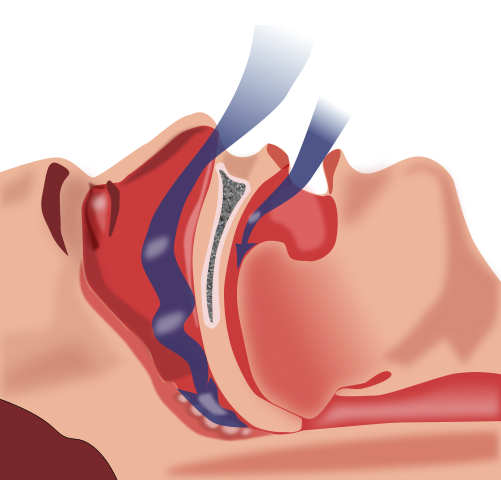
Obstructive Sleep Apnea
In this article, we will comprehensively address the topic of obstructive sleep apnea. We will start by defining the condition. Then, we will highlight its main symptoms and the consequences it can have on the human body if left untreated. Finally, we will take a look at some treatment options and lifestyle changes that can help you mitigate associated symptoms and perhaps cure the condition entirely.
Obstructive Sleep Apnea – Definition
Obstructive sleep apnea is a blockage of the upper airway during sleep due to collapsing soft tissue around the airway. Its defining characteristics are repeated breathing pauses, or very light breathing, during sleep. These breathing irregularities can occur many times during one sleep cycle. Every instance of paused or impaired breathing is called an apnea (Greek – without breath). One apnea usually lasts for 20 to 40 seconds and is triggered by the obstructed airway. The condition is strongly associated with snoring and with sleeping with your mouth open.
During sleep, muscles around the airway tend to relax. During deeper sleep especially, they can relax completely. If the soft tissue surrounding the airway has lost some of its normal properties (this can happen for a variety of reasons) or if breathing and neck muscles have lost their strength, the airway can become blocked, partially or completely, impeding normal breathing and causing hypoventilation (slow breathing rate). This can lead to sleep hypoxia (oxygen deprivation), which can have lead to long-term health consequences, including chronic disease.
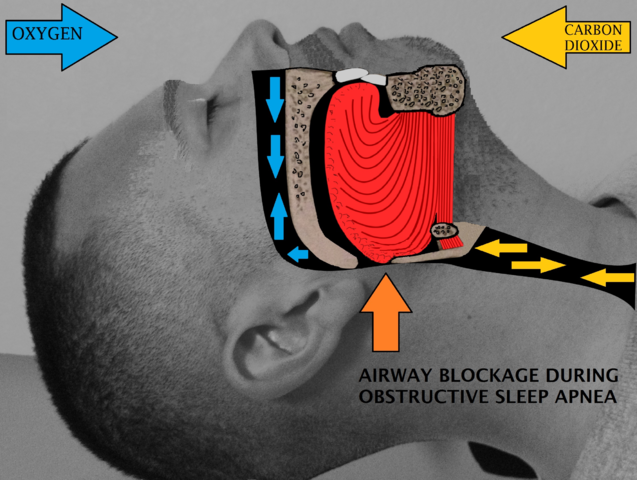
Soft tissues collapsing on the upper airway
People suffering from obstructive sleep apnea are not usually aware that something is wrong during sleep and often believe that existing daytime symptoms have other causes. The only way to identify obstructive sleep apnea is to have your sleep observed by someone else, this also being the reason why many people who sleep alone never get a diagnosis.
Obstructive sleep apnea can remain undetected for many years, determining severe health consequences and decreases in the quality of life. In many cases, individuals grow to accept their daytime symptoms as a part of normal life and are only diagnosed much later in life. In other cases, obstructive sleep apnea is associated with temporary illnesses and conditions, and can disappear and relapse in accordance to these.
Statistically, many people have (unknowingly) experienced obstructive sleep apnea at some point in their lives, and the condition has not necessarily persisted if the triggering factors were removed.
Obstructive Sleep Apnea Symptoms, Signs, and Risks
Obstructive sleep apnea can be hard to detect by yourself. If you carefully study your daily performance and eliminate other obvious causes, you might observe the following signs and symptoms which could indicate that you are suffering from obstructive sleep apnea:
- Daytime sleepiness (sometimes excessive). One of the tell-tale signs most commonly associated with obstructive sleep apnea is daytime sleepiness. This is defined as an almost uncontrollable urge to sleep every now and again during the day. Sleepiness occurs during moments of relaxation but in more severe cases it can also occur during periods of intense activity. In cases of severe obstructive sleep apnea, the desire to sleep can sometimes be strong enough to overcome social considerations and can cause major workplace problems or other inconveniences.
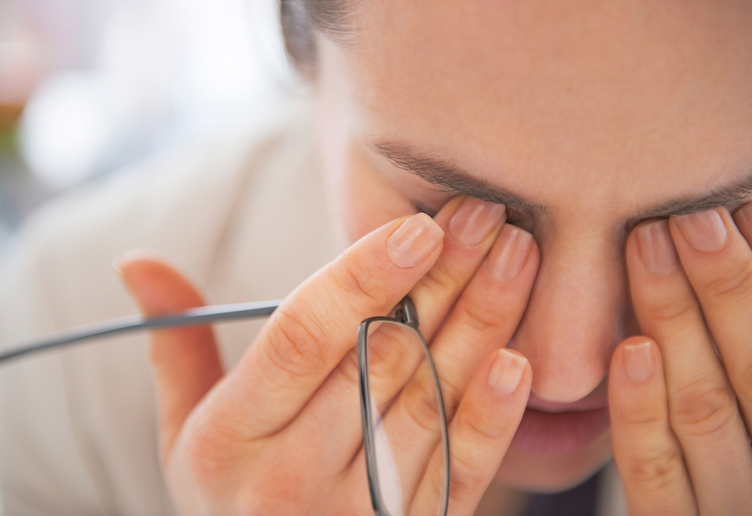
Extreme fatigue caused by sleep apnea
- Snoring is also closely associated with obstructive sleep apnea. It is caused by the air forcing itself between soft tissue partially blocking the upper airway. Snoring can cause further damage to surrounding tissue due to the constant vibration it produces. Apnea-related snoring is also accompanied by other sounds and gasps for air. Because snoring in women is socially frowned upon, women are less likely to be told that they are snoring and thus are less likely to be diagnosed.
- Loss of concentration. Obstructive sleep apnea can have consequences which are similar to those of sleeping deprivation when it comes to the neurological influence. A poor ability to concentrate during the day, a lack of interest for daily tasks and a constant feeling of mental fatigue, all of them without apparent reasons, are red flags for sleep apnea.
- Morning headaches are not uncommon and occur due to the inability of the body to recover during sleep, combined with hypertension (which is connected to a poor quality of sleep).
- Mood changes/ psychological changes. Obstructive sleep apnea is also connected to mood changes. People suffering from this condition can experience depression, anxiety, and irritability, which can cause difficulties when relating to others and when completing daily tasks.
- Night sweats are also a sign of low-quality sleep, which may be caused by apnea.
- Weight gain is associated with sleep deprivation, or more specifically, with missing out on the good part of sleep (about which we’ll talk in a second), which is exactly what sleep apnea means.
Obstructive sleep apnea in children should not be ignored, as nighttime subconscious distress can inhibit the production of growth hormones, alongside other symptoms also associated with adults. Infants and toddlers will require specialized pediatric care if they suffer from this condition.
Causes of Obstructive Sleep Apnea
Obstructive sleep apnea is often associated with the following causes and risk factors:
- Weight gain. Obesity is the main trigger of obstructive sleep apnea because it favors the accumulation of fat tissue around the upper airway. The extra fat will contribute to blocking your airway during sleep.
- Age. The strength and flexibility of tissue decrease in time. Aged people are therefore much more exposed to obstructive sleep apnea than younger adults. The risk is greater if the person’s age is combined with other risk factors, such as obesity.
- Sex. Men are more likely to suffer from obstructive sleep apnea than women, particularly during youth and mid-life. The specific hormones produced by women before menopause play a role in preventing the loss of structure and flexibility of soft tissue in the upper airway. However, after menopause, the prevalence of the syndrome becomes similar in both men and women. The relative rarity of snoring in women when compared to men is also partly determined by hormonal factors and may very well have created the unspoken social stigma associated with women who snore.
- Genetic factors can play an important part in calculating the risk of developing obstructive sleep apnea. Genes will mainly influence structural elements of the upper respiratory system (shape and strength of tissue) but can also play a major role in predisposing the body to a wide range of other determining factors which are strongly interconnected and difficult to pinpoint.
- A connected craniofacial syndrome or disability. Some craniofacial syndromes which are defined, among others, by irregular shapes of the skull and cranial tissue, are also associated with obstructive sleep apnea due to abnormal tissue structures in the upper airway. The Down syndrome, for instance, is very closely associated with sleep apnea.
- Surgery complications. Some throat and/or cranial surgeries can cause changes to the natural state of the soft tissue in the upper airway and expose the patient to subsequent sleep apnea episodes. Additional surgeries might be required to clear the airway.
- Brain or throat injury. Traumatic events can cause obstructive sleep apnea if damage to neck tissue or to cerebral areas controlling relevant muscles occurs. Corrective surgery may be possible, depending on the circumstances.
- Drugs, alcohol, and tobacco (any or all) are all known to have an effect on blood pressure and tissue integrity. Alcohol causes exaggerated muscle relaxation, causing the soft tissues to block the airway during sleep. It is not uncommon for people who do not usually snore to find out that they did so after a night of heavy drinking. Tobacco causes soft tissue inflammation, which can contribute to apnea episodes. Drugs also have an entire set of effects which can encourage sleep apnea and can turn moderate obstructive sleep apnea into a more severe form.
- Viral or bacterial infections can cause obstructive sleep apnea due to the strong tissue inflammation they cause, especially in the upper airway. Recurring tonsillitis, mononucleosis and different types of common colds usually cause mild to severe OSA for limited amounts of time (mild cases are also referred to as hypopnea). In otherwise healthy individuals, sleep apnea should cease after recovery from the disease. In others, the disease can cause small changes in tissue structure, which can favor sleep apnea.
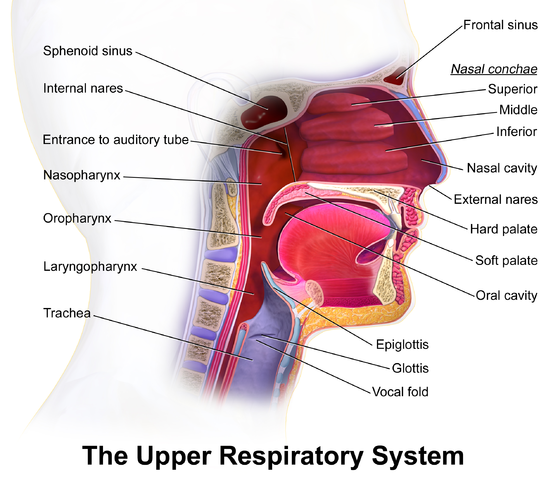
Pathophysiology
To better understand how obstructive sleep apnea can affect your sleep, let’s take a look at the basic sleep cycle and see how sleep apnea affects its functions.
Normal human sleep is divided into 1) non-REM and 2) REM, with REM standing for rapid eye movement, the last period of sleep. The non-REM part of sleep in turn divided into three stages. The third stage, the deepest sleep, is associated with physical restoration of the body, while the others play an important role in mental recovery. Obstructive sleep apnea during any of these sleep periods will negate the positive effects of that particular stage and will be felt throughout the next day.
This is why it would be ideal to have your sleep analyzed by a specialist in order to determine which part of sleep is being affected and which treatment would consequently work best.
Treatments
Modern medicine provides a wide range of solutions and options for doctors in order to treat obstructive sleep apnea. The first step that anyone should take is to quit alcohol and tobacco and to replace them with exercising and healthy diets aimed at weight loss. You can check out some strategies to losing weight fast here. In parallel to this, your doctor could recommend any of the following medical solutions:
- Physical intervention usually refers to a medical breathing machine which pushes air into your lungs with a little extra force than you would normally use, the pressure being sufficient to ensure a steady oxygen flow during sleep. The most popular such machines are the Continuous Positive Airway Pressure devices (CPAP) which ensure a healthy pulmonary airflow throughout the night. A mouthpiece can also be alternatively used whenever the CPAP is impractical.
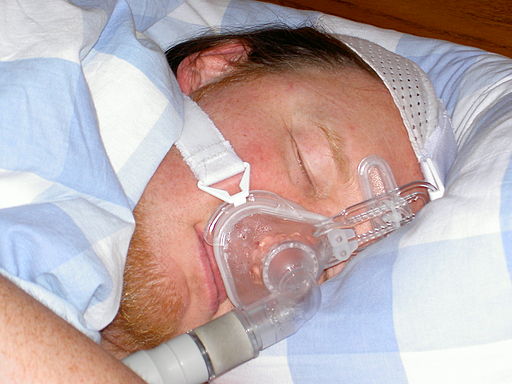
CPAP Machine ensures nighttime oxygen supply
- Surgery is used to modify airway structure in mild to severe cases of obstructive sleep apnea. There are a number of different procedures which can be done, depending on what type of tissue is blocking the airway and where.
- Muscle stimulation implies electrical stimulation of nerves and muscles in the throat in order to increase muscle strength and thus prevent tissue from blocking the airway during sleep.
- Radiofrequency ablation therapy is a method by which tissue interfering with the airway is removed by using low-frequency radio waves emitted from a specialized medical appliance.
Learn more about treating sleep apnea here.
Obstructive Sleep Apnea – Conclusions
Obstructive sleep apnea is not something one should take lightly, due to the serious consequences that long-term oxygen deprivation can have on the human brain. If you suspect you are at risk of having or developing obstructive sleep apnea, speak to your doctor and ask for a referral to a sleep specialist. Finally, a healthy lifestyle will greatly improve obstructive sleep apnea symptoms. Treatment for obstructive sleep apnea is readily available and can be provided across the United States. If the treatment is done correctly, the condition can be readily cured.

Leave a Comment